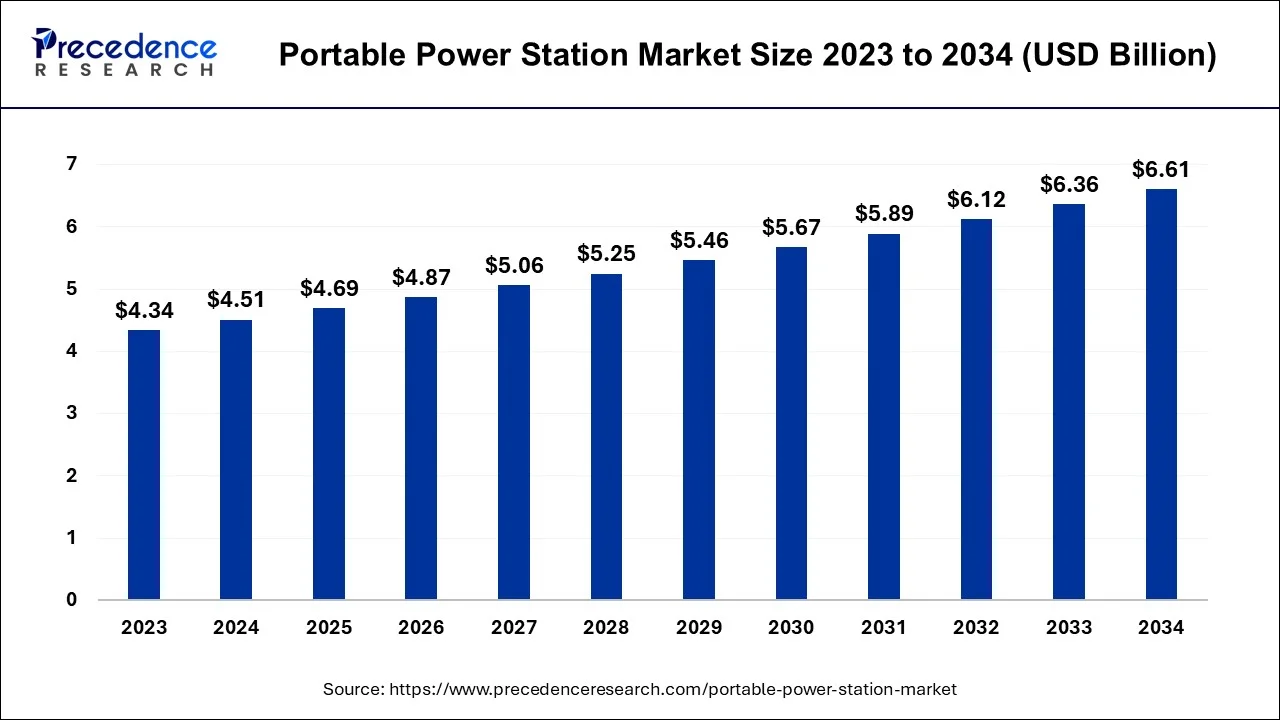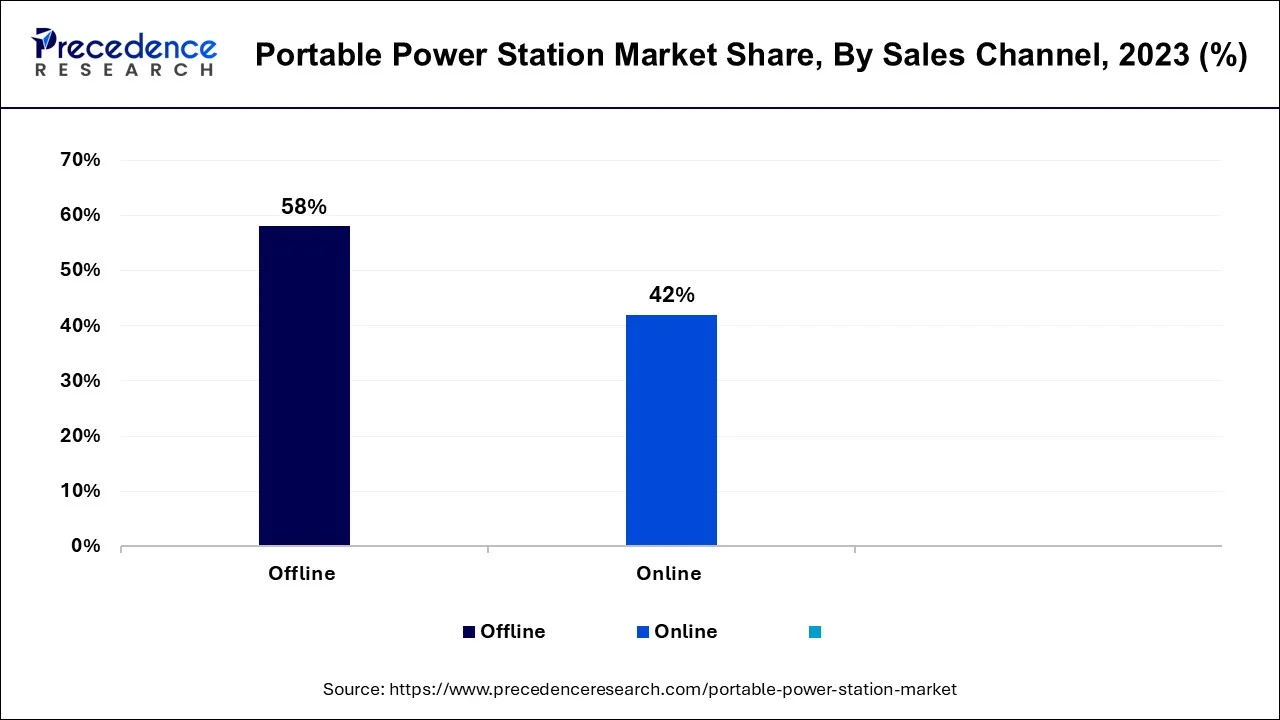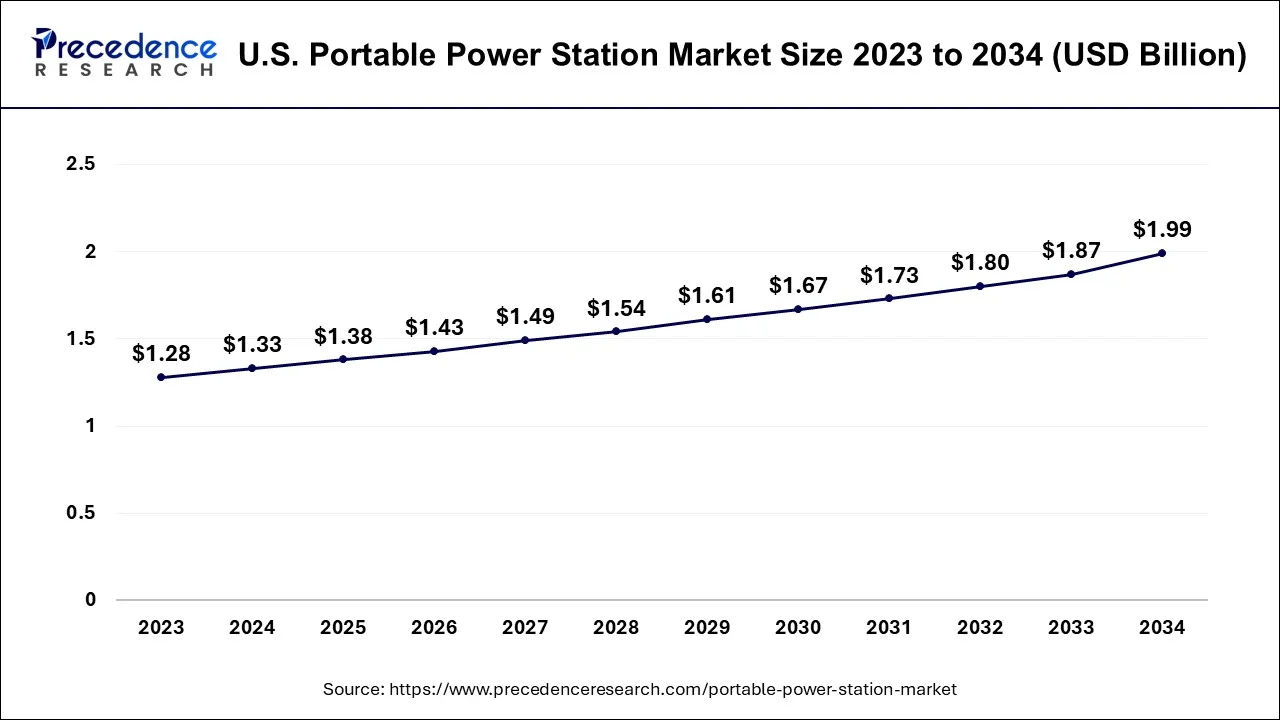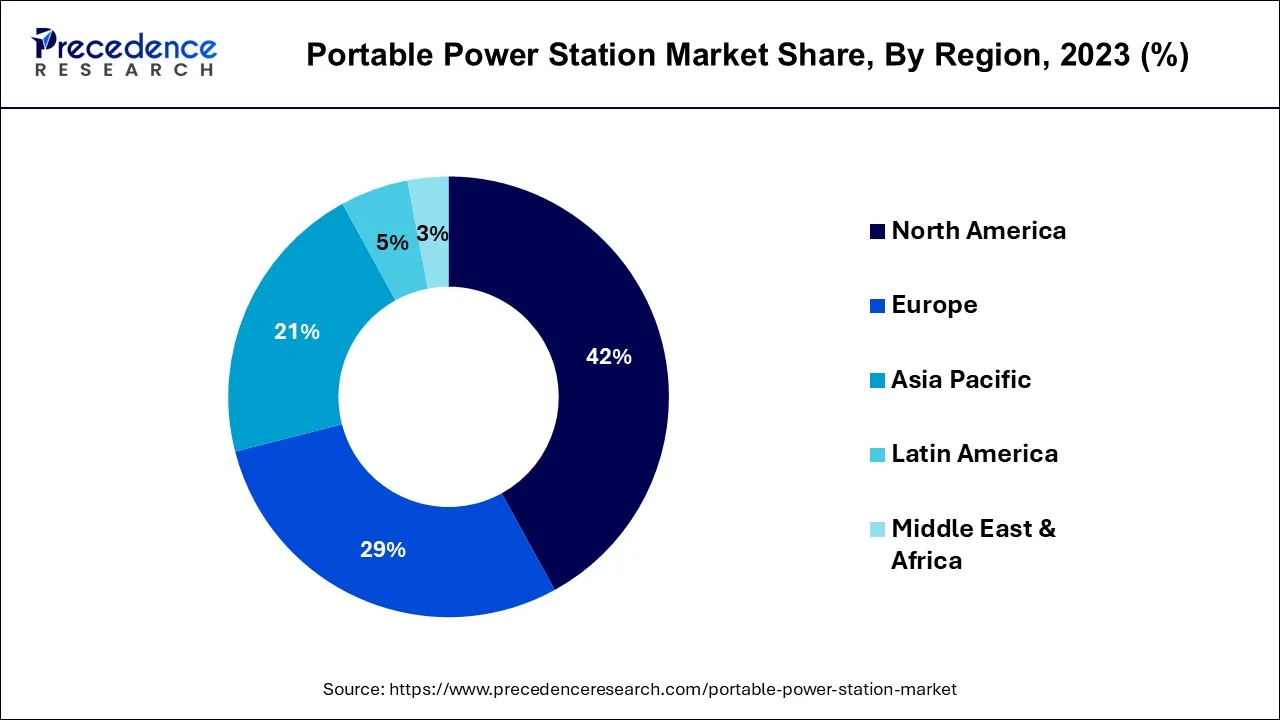List of Contents
What is the Portable Power Station Market Size?
The global portable power station market size is valued at USD 4.69 billion in 2025 and is predicted to increase from USD 4.87 billion in 2026 to approximately USD 6.61 billion by 2034, growing at a CAGR of 3.90% between 2025 and 2034.

Portable Power Station Market Key Takeaways
- North America contributed more than 42% of revenue share in 2024.
- Asia Pacific is estimated to expand the fastest CAGR between 2024 and 2034.
- By Type, the 501-1000Wh segment has held the largest market share of 44% in 2024.
- By Type, the more than 1500Wh segment is anticipated to grow at a remarkable CAGR of 4.8% between 2025 and 2034.
- By Application, the emergency power segment generated over 48% of revenue share in 2024.
- By Application, the automotive segment is expected to expand at the fastest CAGR over the projected period.
- By Sales Channel, the offline segment had the largest market share of 58% in 2024.
- By Sales Channel, the online segment is expected to expand at the fastest CAGR over the projected period.
Market Overview
The portable power station market refers to the industry and market segment associated with the development, manufacturing, and sale of portable power stations. Portable power stations are compact and versatile devices designed to provide electrical power on the go. They typically include built-in batteries, inverters, charging ports, and various outlets to power or recharge electronic devices, appliances, and tools.
The portable power station market has witnessed substantial expansion in recent years, primarily propelled by the heightened demand for off-grid and backup power solutions. These compact, rechargeable units serve as versatile sources of electricity for an array of electronic devices and appliances, making them particularly sought-after for outdoor adventures, emergencies, and remote locales.
What's Causing such an Increase in Demand for Portable Power Stations Globally at This Time?
The demand for portable power stations is booming due to consumers wanting to use clean, renewable sources of energy to perform activities such as outdoor entertainment, emergency preparations, home power generation, and professional use. With the growth in the number of electric devices and the frequency of power outages, demand is growing rapidly across all categories within the individual, industrial, and commercial sectors.
The growth is also further heightened with new advancements in battery performance, solar integration, and fast charge technology supplied by companies such as EcoFlow.
Portable Power Station Market Growth Factors
- The increasing need for power in areas with limited access to conventional electricity grids is observed to propel the market's growth.
- Greater emphasis on having reliable backup power during emergencies and natural disasters supplements the market's growth.
- A shift towards remote work and travel, necessitating portable power sources for electronic devices. Continuous improvements in battery technology and power station design.
- The proliferation of smartphones, tablets, laptops, and other devices requires power on the go.
- Subsidies and incentives for renewable energy products also promote the expansion of the portable power station market.
Market Outlook
- Industry Growth Overview: The market is projected to experience double-digit growth in the coming years due to a growing demand by consumers for portable power stations for recreational travel, home backup, and for emergency power needs. Continued innovation in technology will further increase the level of adoption for Portable Power Stations.
- Sustainability Trends: Portable power station manufacturers are shifting to recyclable materials, solar-ready designs, and low-carbon infrastructure. The movement to LFP Batteries and renewable-powered charging will also create long-term sustainable products.
- Global Expansion: Asia-Pacific, Europe, and the Americas are currently experiencing a high level of product introductions and partnerships that will enable portable power station brands to expand their distribution and provide portable power stations to meet the needs of different types of consumers.
Market Scope
| Report Coverage | Details |
| Market Size in 2025 | USD 4.69 Billion |
| Market Size in 2026 | USD 4.87 Billion |
| Market Size by 2034 | USD 6.61 Billion |
| Growth Rate from 2025 to 2034 | CAGR of 3.90% |
| Largest Market | North America |
| Base Year | 2024 |
| Forecast Period | 2025 to 2034 |
| Segments Covered | Type, Application, Sales Channel, and Region |
| Regions Covered | North America, Europe, Asia-Pacific, Latin America, and Middle East & Africa |
Market Dynamics
Drivers
Outdoor activities
The portable power station market is experiencing notable growth, primarily due to the increasing popularity of outdoor recreation and camping activities. Outdoor enthusiasts are recognizing the value of portable power stations as reliable sources of electricity in remote settings. These devices provide power for lighting, cooking, charging electronic devices, and more, enhancing the overall camping experience. As people seek to stay connected and enjoy modern conveniences while spending time in nature, the demand for portable power stations has surged. Their portability, ease of use, and ability to charge essential gadgets have made them an essential camping accessory.
Restraint
Limited energy capacity
The constrained energy storage capacity of portable power stations serves as a notable impediment to the market's expansion. These devices are engineered to be compact and easily transportable, which necessitates limitations in the volume of energy they can store. While they excel at charging small gadgets or powering low-energy appliances, their constrained capacity can pose challenges for applications demanding more substantial power reserves. Consumers with requirements for powering multiple appliances or sustaining power-hungry devices over extended durations might find the limited capacity of portable power stations to be a drawback.
This limitation becomes particularly acute during protracted power outages or when operating high-wattage equipment in remote, off-grid environments. The limitation of energy capacity also influences the suitability of portable power stations for specific industrial or commercial uses where a resilient and uninterrupted power supply is essential. Consequently, the key to broadening the market's potential and catering to the diverse energy requisites of consumers across various sectors lies in addressing these capacity constraints through innovations in battery technology and product design.
Opportunity
Expansion of renewable energy integration
The burgeoning integration of renewable energy sources presents a substantial window of opportunity within the portable power station market. In a world that cares more and more about using clean energy, portable power stations work really well with renewable sources, especially solar panels. This integration facilitates the efficient capture and storage of clean energy. The potential lies in positioning portable power stations as a pivotal link between renewable energy generation and immediate energy consumption. Users can harness solar power during daylight hours, store it within these stations, and then access it during nighttime or off-grid situations.
This dynamic proves particularly advantageous for outdoor excursions, events, and emergency power backup. It not only diminishes reliance on fossil fuels but also offers a mobile and environmentally responsible energy alternative. Furthermore, governmental incentives and environmental advocacy further encourage consumers to incorporate portable power stations into their renewable energy strategies. With the continued advancement of renewable energy technologies, the harmonious interplay between these technologies and portable power stations ushers in a realm of market expansion and innovation.
Type Insights
According to the type, the 501-1000Wh segment has held 44% revenue share in 2023. The 501-1000Wh segment holds a significant share in the portable power station market due to its versatile capacity. This range strikes a balance between portability and power output, making it ideal for a wide array of applications. It can efficiently charge multiple devices, run small appliances, and provide extended backup power during emergencies. This versatility caters to various consumer needs, from outdoor enthusiasts to those seeking reliable home backup solutions. It offers a sweet spot between capacity and portability, contributing to its prominent market share in meeting the diverse power requirements of users across different scenarios.
The more than 1500Wh segment is anticipated to expand at a significantly CAGR of 4.8% during the projected period. The more than 1500Wh segment holds a substantial growth in the portable power station market due to its capacity to cater to a broader spectrum of power-hungry applications. Users in need of prolonged and high-wattage power rely on these larger-capacity units for activities such as running appliances, medical equipment, and even small off-grid residences. The versatility and extended runtime these models offer make them an attractive choice, particularly in scenarios requiring continuous power supply and where smaller capacity units may fall short, solidifying their significant market growth.
Application Insights
Based on the application, the emergency power generator segment is anticipated to hold the largest market share of 48% in 2024. The emergency power segment dominates the portable power station market due to its critical role in ensuring a reliable backup power source during unforeseen outages and disasters. These versatile units offer a lifeline for charging essential devices, medical equipment, and sustaining communication in times of crisis.
The increasing frequency of natural disasters and a growing awareness of disaster preparedness have fueled the demand for emergency power solutions. Moreover, the COVID-19 pandemic heightened the need for home-based emergency power as remote work and online learning became prevalent, solidifying the emergency power segment's significant share in the portable power station market.
On the other hand, the automotive segment is projected to grow at the fastest rate over the projected period. The dominant growth of the automotive segment in the portable power station market can be attributed to its strong compatibility with electric vehicles (EVs). Portable power stations offer a practical and adaptable solution for EV users, facilitating on-the-go vehicle charging, especially in regions with sparse charging infrastructure.
This symbiotic relationship between portable power stations and EVs has significantly driven market expansion, coinciding with the continuous growth of the electric vehicle industry. Furthermore, the automotive sector's influence extends to the provision of power for an array of devices and tools during road journeys and outdoor adventures, underscoring its pivotal role in the portable power station market.
Sales Channel Insights
In 2024, the offline segment had the highest market share of 58% on the basis of the sales channel. The offline segment holds a major share in the portable power station market primarily due to the well-established network of brick-and-mortar retail stores, including electronics shops, home improvement centers, and department stores. Consumers often prefer to physically inspect and purchase these products, ensuring product quality and compatibility.
Additionally, in-store experiences allow potential buyers to receive expert advice and recommendations, instilling a sense of trust. As portable power stations are considered valuable investments, the offline segment capitalizes on this tactile and consultative approach, making it the dominant distribution channel, although the online segment is also growing rapidly.

The online segment is anticipated to expand at the fastest rate over the projected period. The online segment holds a major growth in the portable power station market due to several key factors. Online platforms offer consumers a wide array of product options, enabling easy comparison and research. This digital landscape fosters convenience, allowing users to make informed decisions.
Additionally, the online market provides access to a global customer base, eliminating geographical limitations. E-commerce platforms also offer competitive pricing, discounts, and user reviews, building trust and boosting sales. The rapid growth of online shopping, especially during the COVID-19 pandemic, has further propelled the dominant growth of the online segment in the portable power station market.
Regional Insights
U.S. Portable Power Station Market Size and Growth 2025 to 2034
The U.S. portable power station market size is estimated at USD 1.38 billion in 2025 and is expected to be worth around USD 1.99 billion by 2034, rising at a CAGR of 4.11% from 2025 to 2034.

North America has held the largest revenue share of 42% in 2024. North America commands a significant share in the portable power station market due to several factors. The region's growing awareness of environmental sustainability has boosted the demand for clean energy solutions. Frequent natural disasters have increased the need for reliable backup power sources. High outdoor activity participation, including camping and RV travel, drives sales of portable power stations. Advanced battery technology and the popularity of electric vehicles have further bolstered the market.
North America's stable economy, tech-savvy consumer base, and robust e-commerce infrastructure have facilitated market growth, making it a dominant player in the global portable power station industry.

Asia Pacific is estimated to observe the fastest expansion. Asia Pacific commands a substantial share of the portable power station market for several reasons. First, the region experiences high demand for off-grid power solutions due to unreliable or limited access to electricity in many areas. Second, the increasing adoption of outdoor and recreational activities, coupled with a surge in natural disasters, fuels demand for these devices.
Additionally, Asia-Pacific hosts a significant manufacturing hub for portable power stations, resulting in competitive pricing. Finally, growing awareness of environmental sustainability and government initiatives promoting clean energy solutions have further boosted the market in the region.
What is Driving Portable Power Station Growth Across Latin America?
Due to an increase in outdoor travel and camping culture, remote working setups, and increased prevalence of climate-related power interruptions, Latin America's growth as a potential marketplace for Portable Power Stations is beginning to take off.
In Brazil, Mexico, and Chile, consumers are purchasing more compact, solar-ready stations for camping, home energy support, and for recreational and DIY purposes. Furthermore, by making renewable energy a national priority through government initiatives and declining lithium-ion battery costs, retail and e-commerce channels are about to bloom in Latin America.
In What Way is Europe Leading the Way in the Industry Transition to Sustainable Portable Energy Solutions?
As a major stakeholder in the global market, Europe has been very successful in establishing a large market share through the implementation of strict sustainability guidelines, widespread acceptance of clean technology as a means to support sustainable energy goals, and an ever-increasing demand from consumers for Off-grid portable power solutions.
The rise in caravan tourism, Smart Outdoor Recreation and remote professional jobs has created a demand for portable power stations in Germany, the UK, France and the Nordic region due to the preference of European consumers towards environmentally friendly low noise solar-compatible power systems and their desire to have access to environmentally friendly and low-priced products produced by manufacturers such as Bluetti, Anker, Eco-flow and others.
What are the Main Stages of the Portable Power Station Value Chain?
The portable power station value chain includes the sourcing of raw materials (Lithium-ion cells and inverters), component manufacturing, assembly of systems, distribution, and after-sales support. Portable power station manufacturers rely heavily on global supply chains to acquire high-density batteries and integrate advanced power management systems into their products in addition to utilizing distributors, retailers, and online marketplaces to get their products into the hands of the consumer and service partners to provide maintenance and warranty support to their consumers.
- Advanced Battery Engineering: Portable power station manufacturers are spending a considerable amount of money on the development of higher-capacity and safer lithium-ion and LFP batteries to improve the efficiency and lifespan of their products.
- Smart Integration and IoT Monitoring: Portable power station manufacturers have started to integrate mobile apps with their systems, provide real-time diagnostics to their customers, and implement smart charging technology to provide more personalized customer experiences and to enhance remote management capabilities.
- Effective Distribution Ecosystems: By forging strong relationships with e-commerce giants, specialty retailers, and energy solutions providers, portable power station manufacturers can effectively increase their penetration into the global market.
Portable Power Station Market Companies
- Goal Zero
- Jackery
- Anker
- EcoFlow
- Bluetti
- Rockpals
- Maxoak
- Suaoki
- Renogy
- Yeti Cycles
- RavPower
- Nitecore
- Honda
- Kalisaya
Recent Developments
- In June 2025, Jackery introduced Jackery 3000 v2, a promising product not just for power but also a new level of performance, durability, and smart functionality. This delves into the advanced features, technological enhancements, and practical benefits, making the Jackery Solar Generator 3000 v2 a compelling choice for anyone seeking dependable energy on the go or at home.
- In February 2024, EcoFlow launched the latest portable power station, DELTA 2 Max. This powerful ally for adventures and home comfort boasts a base capacity of 2,048Wh, expandable up to 6,144Wh with two extra batteries. Overall, it presents an ideal solution to fulfill your diverse electricity needs, whether for RV trips, 4WD, other outdoor adventures, or home comfort with more portability and reliability.
- In August 2023, Anker introduced the new Anker SOLIX brand and the company's new line of home energy solutions, including several products for homes and apartments. Anker SOLIX unveiled the Anker SOLIX C1000 Portable Power Station and Anker SOLIX F3800 Portable Power Station, redefining a new standard on power energy independence by offering powerful outdoor adventures and ensuring their dependable home power backup solution at incredible savings over traditional home backup solutions.
- In August of 2022, Goal Zero entered into a strategic partnership with Yeti Cycles, a prominent manufacturer of high-performance mountain bikes. Under this collaboration, Goal Zero seamlessly integrated its portable solar panels and compact power banks into Yeti Cycles' bicycle designs and accessories. The objective was to offer a reliable and continuous power source for off-grid biking adventures.
Segments Covered in the Report
By Type
- Less than 500 Wh
- 501-1000 Wh
- 1001-1500 Wh
- More than 1500 Wh
By Application
- Emergency Power
- Off-Grid Power
- Automotive
By Sales Channel
- Online
- Offline
By Geography
- North America
- Europe
- Asia-Pacific
- Latin America
- Middle East and Africa
For inquiries regarding discounts, bulk purchases, or customization requests, please contact us at sales@precedenceresearch.com
Frequently Asked Questions
Ask For Sample
No cookie-cutter, only authentic analysis – take the 1st step to become a Precedence Research client